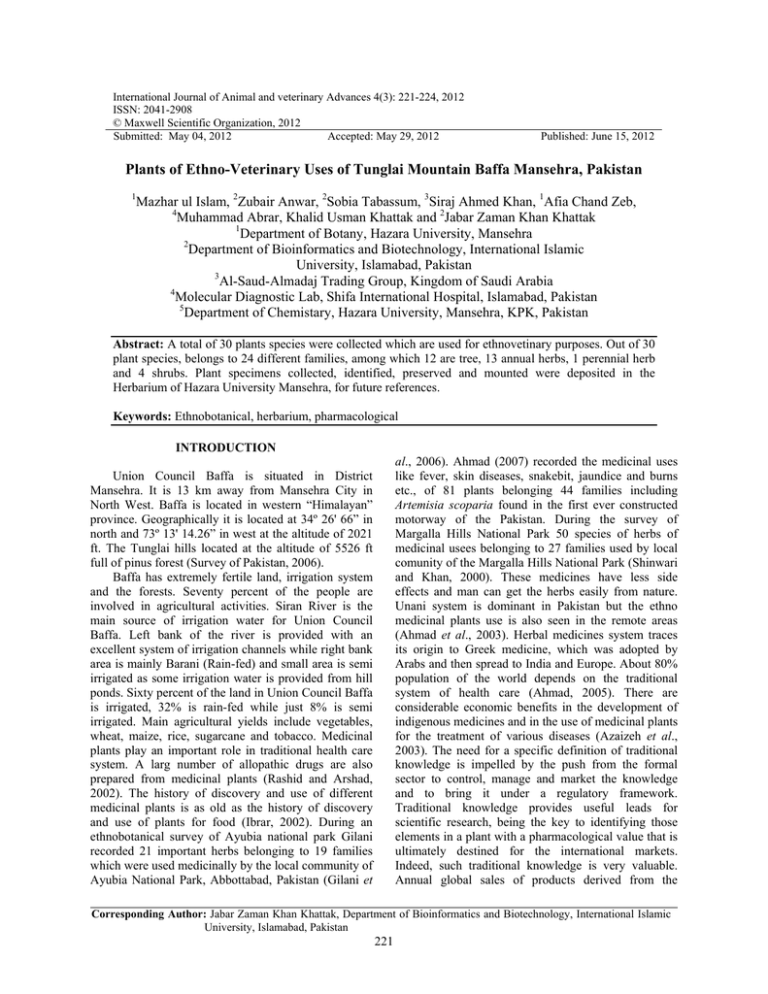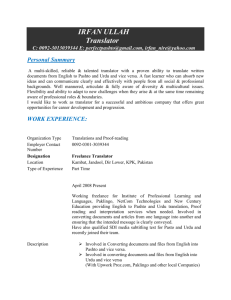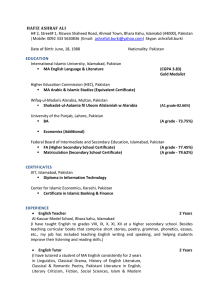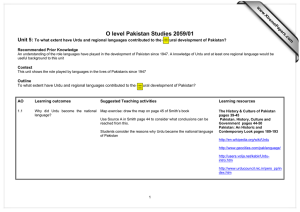International Journal of Animal and veterinary Advances 4(3): 221-224, 2012
advertisement

International Journal of Animal and veterinary Advances 4(3): 221-224, 2012 ISSN: 2041-2908 © Maxwell Scientific Organization, 2012 Submitted: May 04, 2012 Accepted: May 29, 2012 Published: June 15, 2012 Plants of Ethno-Veterinary Uses of Tunglai Mountain Baffa Mansehra, Pakistan 1 Mazhar ul Islam, 2Zubair Anwar, 2Sobia Tabassum, 3Siraj Ahmed Khan, 1Afia Chand Zeb, 4 Muhammad Abrar, Khalid Usman Khattak and 2Jabar Zaman Khan Khattak 1 Department of Botany, Hazara University, Mansehra 2 Department of Bioinformatics and Biotechnology, International Islamic University, Islamabad, Pakistan 3 Al-Saud-Almadaj Trading Group, Kingdom of Saudi Arabia 4 Molecular Diagnostic Lab, Shifa International Hospital, Islamabad, Pakistan 5 Department of Chemistary, Hazara University, Mansehra, KPK, Pakistan Abstract: A total of 30 plants species were collected which are used for ethnovetinary purposes. Out of 30 plant species, belongs to 24 different families, among which 12 are tree, 13 annual herbs, 1 perennial herb and 4 shrubs. Plant specimens collected, identified, preserved and mounted were deposited in the Herbarium of Hazara University Mansehra, for future references. Keywords: Ethnobotanical, herbarium, pharmacological INTRODUCTION al., 2006). Ahmad (2007) recorded the medicinal uses like fever, skin diseases, snakebit, jaundice and burns etc., of 81 plants belonging 44 families including Artemisia scoparia found in the first ever constructed motorway of the Pakistan. During the survey of Margalla Hills National Park 50 species of herbs of medicinal usees belonging to 27 families used by local comunity of the Margalla Hills National Park (Shinwari and Khan, 2000). These medicines have less side effects and man can get the herbs easily from nature. Unani system is dominant in Pakistan but the ethno medicinal plants use is also seen in the remote areas (Ahmad et al., 2003). Herbal medicines system traces its origin to Greek medicine, which was adopted by Arabs and then spread to India and Europe. About 80% population of the world depends on the traditional system of health care (Ahmad, 2005). There are considerable economic benefits in the development of indigenous medicines and in the use of medicinal plants for the treatment of various diseases (Azaizeh et al., 2003). The need for a specific definition of traditional knowledge is impelled by the push from the formal sector to control, manage and market the knowledge and to bring it under a regulatory framework. Traditional knowledge provides useful leads for scientific research, being the key to identifying those elements in a plant with a pharmacological value that is ultimately destined for the international markets. Indeed, such traditional knowledge is very valuable. Annual global sales of products derived from the Union Council Baffa is situated in District Mansehra. It is 13 km away from Mansehra City in North West. Baffa is located in western “Himalayan” province. Geographically it is located at 34º 26' 66” in north and 73º 13' 14.26” in west at the altitude of 2021 ft. The Tunglai hills located at the altitude of 5526 ft full of pinus forest (Survey of Pakistan, 2006). Baffa has extremely fertile land, irrigation system and the forests. Seventy percent of the people are involved in agricultural activities. Siran River is the main source of irrigation water for Union Council Baffa. Left bank of the river is provided with an excellent system of irrigation channels while right bank area is mainly Barani (Rain-fed) and small area is semi irrigated as some irrigation water is provided from hill ponds. Sixty percent of the land in Union Council Baffa is irrigated, 32% is rain-fed while just 8% is semi irrigated. Main agricultural yields include vegetables, wheat, maize, rice, sugarcane and tobacco. Medicinal plants play an important role in traditional health care system. A larg number of allopathic drugs are also prepared from medicinal plants (Rashid and Arshad, 2002). The history of discovery and use of different medicinal plants is as old as the history of discovery and use of plants for food (Ibrar, 2002). During an ethnobotanical survey of Ayubia national park Gilani recorded 21 important herbs belonging to 19 families which were used medicinally by the local community of Ayubia National Park, Abbottabad, Pakistan (Gilani et Corresponding Author: Jabar Zaman Khan Khattak, Department of Bioinformatics and Biotechnology, International Islamic University, Islamabad, Pakistan 221 Int. J. Anim. Veter. Adv., 4(3): 221‐224, 2012 Table 1: Plants of ethno-veterinary uses Botanical name Vernacular name Barberis lyceum Sumbal (Hindko, Gojri), royle Koray (Pashto) Verbiscum thepsus Ghadi Kan (Hindko, L Gojri), Kharghuag) Family Barbedaceae Habit Shrub Parts used Root bark Schryophylaceae Annual herb Leaves and stem with inflorescence Annual herb Annual herb Leaves, seeds oil Brasica compestris L Rumex hustatus L Saryan (Hindko, Gojri), Sharsham (Pashto) Khateemal (Hindko, Gojri), Turakhay (Pashto) Crucifereae Pinus roxbergii Cheer (Hindko, Gojri, Urdu), Nakhtar (Pashto) Hund (Hindko, Pashto, Gojri), Kasni (Urdu) Pinaceae Tree Resin and leaves Astaraceae Annual herb Whole plant Cychorium intybus L Polygonaceae Whole plant Ethno botanical uses As analgesic, as a bandage & as body coolant As stomachic & as analgesic As fodder, tonic, for gastric problems For blood clotting (septic) & for healing As septic, for wound healing & resin used as hair removing For stomach problem, antiinflammatory agent & as fodder crop For gastric problem & digestive problems. As anthelmentic and febrifuge. As fodder for sheep’s, goats For removal of ringworms (anthelmentic). As laxative Melia azed-arch Daraik (Hindko, Gojri), Bekana (Pashto), Bekyne (Urdu) Meliaceae Tree Leaves and fruits Mallotus phelipenses lam. mull Riccinus comunis L Witex negudo Kamila (Hindko, Gojri), Kambeela (Pashto) Euphorbiaceae Tree Fruits and leaves Aranda (Hindko, Gojri Pashto), Arand (Urdu) Marvandi (Hindko, Pashto) Euphorbiaceae Under tree Seeds and oil Verbenaceae Tree Leaves Zanthoxylum armetum L Adhathoda vesica L Timber (Hindko, Gojri), Dambara (Pashto) Bekar (Hindko, Gojri, Pashto) Rotaceae Shrub Leaves and fruits Acanthaceae Shrub Leaves and flowers Cynodon dactylon L Khabal (Hindko, Pashto, Gojri) Poaceae Annual herb Stem and leaves Alllium sativa L Thom (Hindko), Ooga (Pashto), Lehsan (Urdu) Sounf (Hindko, Urdu, Gojri) Papra (Hinko, Pashto, Gojri, Urdu) Aliaceae Perennial herb Annual herb Annual herb Underground stem and leaves Whole plant Punica granatum L Solanum surratense L Anar (Urdu), Anargoordy (Pashto) Peeli mordhi, Kandiari (Hindko, Panjabi, Gojri) Punicaceae Tree Periarp (fruit) Solenaceae Annual herb Whole plant Mentha longifolia L Chita podina (Hindko, Gojri), Safaid podina (Urdu) Tahli (Hindko, Gogri, Panjabi), Shuwa (Pashto) Sheesham (Urdu) Lamiaceae Annual herb Arial parts Papilionaceae Tree Leaves Leaves are given as coolant, as fodder for sheep’s goats Sonchal (Hindko, Gojri), Panerak (Pashto, Kohistani) Barun (Hindko, Gojri), Dadam (Pashto) Malvaceae Annual herb Leaves, stem, seeds Poaceae Annual herb Stem, leaves and seeds Morus alba L Chita toot (Hindko, Gojri), Spin toot (Pashto), Shahtoot (Urdu) Moraceae Tree Leaves Morus nigra L Kala toot (Hindko, Gogri), Tora Toot) Pashto),Toot siyah (Urdu) Moraceae Tree Leaves and fruits In digestive problem , for food poisoning,as fodder, but excess amount cause loose motion To clout blood (steptic, analgesic and antiseptic) as fodder and also tonic Commonly leaves are used as fodder. In excess amount cause loose motion. It is also laxative and tonic The leaves are used as fodder for sheeps, goats and cows. These are also tonic and laxative Feoniculum valgare mill Fumeria indica L Delbergia sesso L Malva neglecta L Sargham helipense L Apiaceae Fumeraceae 222 Whole plant To sheep’s and goats to create sterility for one year. As laxative For stomach problems & As fodder for sheep’s and goats Used in fever and flue (Febrifuge). Iin stomachic For rashes; sometime veterinaries are bathed with plant infusion & for febrifuge As fodder for veterinaries. As tonic, antiseptic and analgesic. For wounds for blood clouting, relieving pain For stomachic & for influenza Carminative, purgative, in fever & a diuretic To control constipation and urinary problems in cattle. As a fodder & fever As vermifuge & to expel the intestinal worm For fever, cough and intestinal infection and also to improve feeding As (stomachic) and (febrifuge) Int. J. Anim. Veter. Adv., 4(3): 221‐224, 2012 Table 1: (Continue) Botanical name Salix longifolia L Rubas fruiticisus L Ficus carica L Ailanthus altissima (mill.). Swingle Artemisia absenthium L Trichodesma indicum L Vernacular name Beens (Hindko) Beensa (Gojri) Karwara (Hindko, Gojri, Pashto) Family Salicaceae Habit Tree Parts used Leaves Rosaceae Shrub Stem, leaves and fruits Phugar (Hindko), Phugari (Gojri), Inzir (Pashto) Darawa (Hindko, Gojri), Shandai (Pashto) Chaow (Hindko, Gojri) Moraceae Tree Latex and leaves Simaroubaceae Tree Resin and leaves To clout the blood antimicrobial activity & kill the flea and ticks Astaraceae Annual herb Leaves, inflorescence and stem Boreginaceae Annual herb Whole plant Stomachic, febrifuge, anthelmentic, antiseptic. Antiworms reduce fever in indigestion and gastric problems As anti-inflammatory). As analgesic) Andholi (Hindko, Gojri) manipulation of genetic resources lie between US$ 500 and US$800 billion annually (Kate and Laird, 1999). Herbal medicine even today plays an important role in rural areas and various locally produce drugs are still being used as household remedies for various diseases specially in these areas for different ailments (Qureshi and Ghufran, 2005). People living in mountains of Pakistan use plants in many ways such as medicines, timber wood, fire wood, food, fodder etc., (Hussain and Khaliq, 1996). This study will help us in finding direct availibilty of cure for the good healthcare of Veterinaries and human as well. We can use these plants for further medicnal products to make usefull in easy way. MATERIALS AND METHODS An ethnovetinary survey was conducted to collect the information from the local people on the use of medicinal plants for medicinal use in Tunglai hills Baffa, District Mansehra NWFP, Pakistan during June 2008-august 2009. The information about native plants used for ethnovetinary purposes collected through questionnaire and personal interviews during field trips. Plants were arranged alphabetically by family name, vernacular name and ethno veterinary uses. The identification of the listed plants was based on The Flora of Pakistan. RESULTS AND DISCUSSION During this survey 30 plants belonging to 24 families are collected and arranged the description of each is given in the tabular form in Table 1. Ethnobotany is perhaps most important method to study natural resources and their Management by indigenous people. It enables us to work with local people to explore Knowledge based on experiences of ages. Unfortunately, there is no provision and/or law for the protection of knowledge rights of native people. Very little action has been taken by legal professional environmental, non-governmental or even human rights groups to secure Intellectual Property Rights (IPR) for native people (Martin, 1995). Livestock keepers in many developing countries with restricted access to orthodox veterinary healthcare services commonly use traditional remedies to treat their animals when disease is encountered. The use of medicinal plants is an option for livestock farmers who are not allowed to use allopathic drugs under certified organic programs or cannot afford to use allopathic drugs for minor health problems of livestock. In Pakistan villagers also use local remedies for the treatment of domestic animals. In most areas of Mansehra District plants are used as veterinary medicines. In hilly areas locals use plant remedies for the cure of veterinary diseases. The have no access to doctors for their animals. They also think that local remedies have low or less side effects. This fact that plants have crud compound but in low quantities which if show side effect that can be overcome easily. CONCLUSION This study will help us in finding direct availibilty of cure for the good healthcare of Veterinaries and human as well. We can use these plants for further medicnal products to make usefull in easy way. REFERENCES Ahmad, H., 2005. Issues regarding medicinal plants of Pakistan. Udyana Today, 6(3): 6-7. Ahmad, M., M.A. Khan and R.A. Qureshi, 2003. Ethnobotanical study of some cultivated plants of chhuchh region (District Attock). J. Hamdard Medicus. 46(3): 15-19. 223 Ethno botanical uses (Febrifuge, pain killer) as fodder for sheep’s, goats Antianemic and tonic to improve the health, as fodder for sheep’s and goats Antiseptic & used to stop the blood Int. J. Anim. Veter. Adv., 4(3): 221‐224, 2012 Ahmad, S.S., 2007. Medicinal wild plants from LahoreIslamabad Motorway (M-2). Pak. J. Bot., 39(2): 355-375. Azaizeh, H., S. Fulder, K. Khalil and O. Said, 2003. Ethnomedicinal knowledge of local Arab practitioners in the Middle East Region. Fitoterapia, 74: 98-108. Gilani, S.A., R.A. Qureshi and S.J. Gilani, 2006. Indigenous Uses of Some Importantethno Medicinal Herbs of ayubia national park, Abbottabad, Pakistan. Ethnobotanical Leaflets. Department of Plant Sciences, Quaid-i-Azam University Islamabad, Pakistan. Hussain, F. and A. Khaliq, 1996. Ethnobotanical studies on some plants of Dabargai Hills. Swat. Proceedings of first training workshop on Ethnobotany and its application to conservation. NARC, Islamabad, pp: 207-215. Ibrar, M., 2002. Responsibilities of ethnobotanists in the field of medicinal plants. In Proceeding of Workshop on Curriculum Development in Applied Ethnobotany, Published by the Ethnobotany Project, WWF Pakistan, 34-D/2, Sahibzada Abdul Qayuum Road Peshawar, Pakistan, pp: 16-20. Kate, K. and S.A. Laird, 1999. The Commercial Use of Biodiversity, Access to Genetic Resources and Benefit-Sharing, Earthscan, London. Martin. G.J., 1995. Ethnobotany, Apeople and Plants Conservation Manual. Chapman and Hall, 2-6 Boundary Row, London SE1 8NH, pp: 268. Qureshi, R.A. and M.A. Ghufran, 2005. Medicinal Value of Some Important Roses and Allied Speciesof Northeren Area of Pakistan. In: Hashmi, M., (Eds.), Pakistan Rose Annual. Pictorial Printers (Pvt.). Ltd. Islamabad, pp: 24-29. Rashid, A. and M. Arshad, 2002. Medicinal plant diversity, threat imposition and interaction of a mountain people community. In Proceeding of Workshop on Curriculum Development in Applied Ethnobotany. Published by the Ethnobotany Project, WWF Pakistan, 34-D/2, Sahibzada Abdul Qayuum Road Peshawar, Pakistan, pp: 84-90. Shinwari, M.I. and M.A. Khan, 2000. Folk use of medicinal herbs of Margalla Hills National park, Islamabad, Pakistan. J. Ethnopharmacol., 69: 45-56. 224





